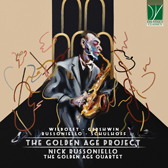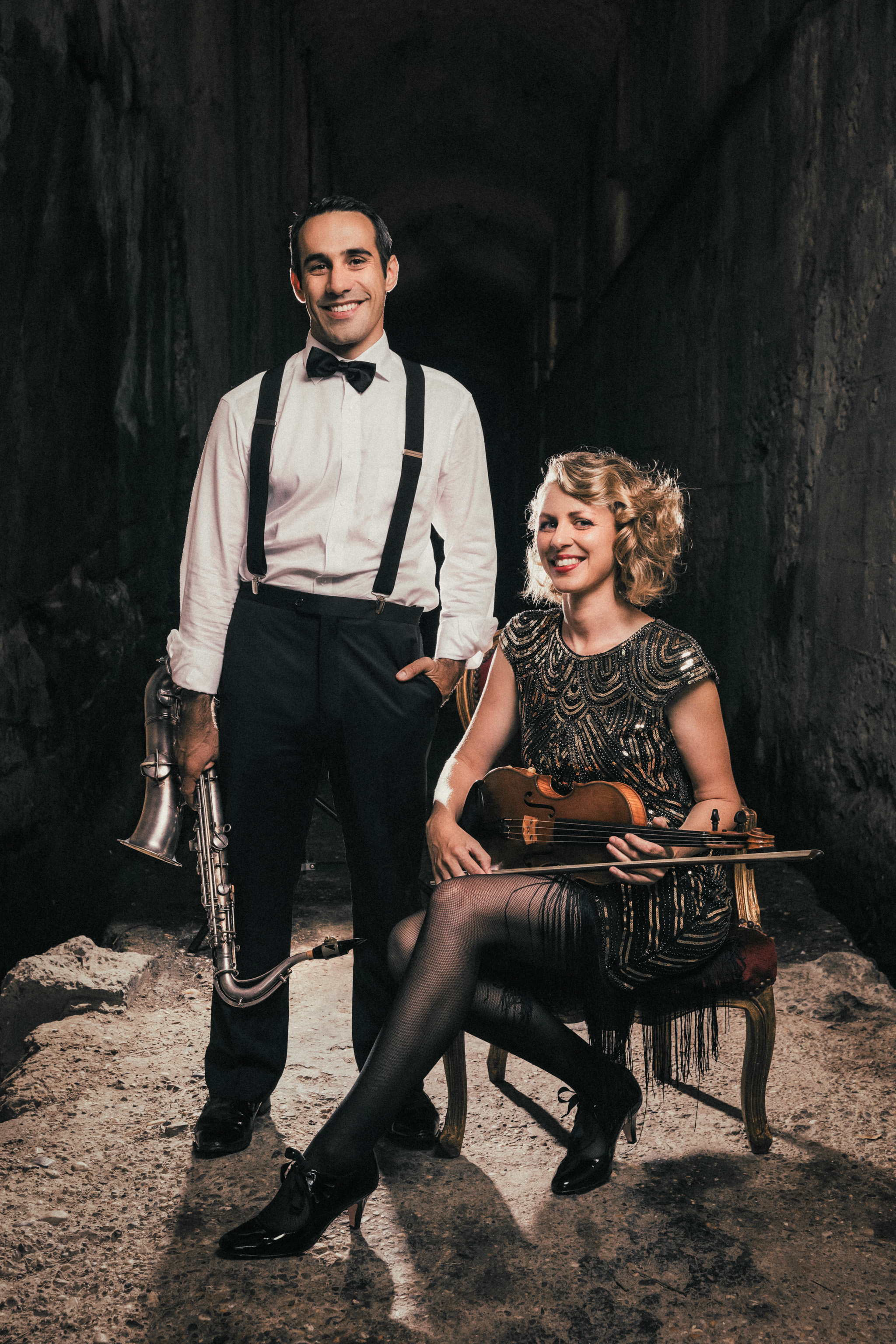31 October 2022
C melody saxophone?
 Image: The Golden Age Project (Da Vinci Classics 2022)
Image: The Golden Age Project (Da Vinci Classics 2022) Nick Russoniello shares why this extremely rare instrument sparked the creative impulse for his new works and album The Golden Age Project (Da Vinci Classics 2022).
My wife Julia is a historical violinist and music researcher, which means we are typically working at opposite ends of the art music spectrum. While she may be considering historic uses of portamento or questioning the possible meanings behind a notated tenuto, I might be wondering how I could strap a tambourine to my saxophone and what this would sound like through a loop pedal. We don't work together often, however, like many couples, we have a bad habit of bringing work home.
In 2016 Julia completed her Masters at the Sydney Conservatorium of Music researching the performance practices of early twentieth-century violinists. To overly simplify, she was (and still is) trying to find out about the nuances of violin performance just before the invention of sound recording. It was a study on what artistic decisions musicians of this era were making and why. I tend to turn most topics of conversations back to the saxophone, so dinner time discussions about Julia's research somehow veered towards the 'saxophone craze' of the 1920s.
The saxophone was THE instrument of the 1920s in the USA. The bubbling optimism of the time combined with the effect of virtuosi such as the Brown Brothers and Rudy Wiedoeft sparked a mania; everyone wanted to play the sax. At the peak of this craze, Kansas City made it illegal to play the saxophone within the city limits between ten-thirty at night and six in the morning. Millions of saxophones were sold and large amateur saxophone clubs sprang up across the country. The craze didn't last, but it did alter the course of Western music history; it brought the saxophone out of obscurity and into public consciousness. Before the 1920s the saxophone was a largely unknown military instrument, afterwards, it was everywhere and was soon picked up by the geniuses of the big band and swing eras that followed.
The king of saxophones during the craze was the C melody saxophone. Unlike the other saxophones, the C melody is at concert pitch which made it hugely popular with amateur saxophonists who wanted to play along with the piano at home sing-alongs. Despite its former popularity, the C melody is now what I like to call an "extinct" saxophone. It is akin to the F Mezzo, Conn-o-sax, soprillo and the slide saxophone that don't get around much anymore. I have been to countless saxophone events, international congresses all over the world, and undertaken many (too many?) years of full-time saxophone study and I had never heard a C melody saxophone played live.
Julia had already started putting together a string quartet playing in an early twentieth century style and we liked the idea of adding a historical saxophone. We both work so hard on separate projects it made sense for us to combine our efforts. One rainy afternoon not long after, I bought a C melody. I jumped on eBay and found an original 1924 Conn C melody for sale. A few impulsive clicks later, the Golden Age Project was underway. When the instrument arrived, l opened the case, and the musty smell of old cigarettes was immediately transportive. The instrument was a dull silver, noticeably smaller and curvier than my other instruments, and decorated in ornate floral engravings. It was clearly a great horn but hadn't been played in some time. I made an emergency visit to the legendary (amongst saxophonists everywhere) repairman Steve Giordano. Steve gave me one of his famous 'what are you doing to me?' sighs but got on with the task of making this special sax sing again. Within two notes of playing on the fully working horn I knew it had been a good purchase. Blowing into the C melody felt like pressing the buttons on a time machine. The experience of playing was so familiar yet so strange. In every way, its sound is more colourful, more nuanced, mellower and softer than its modern counterparts.
The sound of the C melody is perfectly matched with the gut-strung instruments that would have been the norm in the 1920s. We associate the sound of gut strings with baroque and classical period performance; however, it is less known that this string material was still being used in the early twentieth century. Violinists were widely playing on gut strings until the 1930s and then many continued to use a combination of gut, steel wound gut and a 'wire' E string for another decade or so. This factor alone meant that string playing used to sound different.
The gut strings have a completely different sound. They have a more complex tonal palette but are softer and harder to keep in tune, just like a C melody saxophone. To marry these two amazing instrumental colours, I had to get to work arranging music for this project. In my arrangements of works by Weidoeft, Gershwin and Schulhoff (all originally for piano or piano and sax) I wanted to use the string quartet to evoke the tones of the dance orchestras, jazz clubs and rich string sections of the jazz era. This album reimagines what it might have sounded like if someone like Weidoeft had played with a string quartet at the height of the saxophone craze.
I'm primarily a new music musician and felt that this new album needed new music. There are two original new works on the album, Harbour City Suite for saxophone and string trio and Valse Rudy for solo saxophone. Harbour City Suite is a vivid retelling of events happening in 1920s Sydney. The first movement, 'Razorhurst", depicts the violent and somewhat romanticised razor gangs that were highly active in the inner-city suburb of Darlinghurst. The second movement, "Greycliffe", is an elegy for the victims of the deadly Greycliffe ferry disaster of 1927. This collision between the small Greycliffe public ferry and a larger steamer resulted in the death of forty passengers and is still the deadliest accident that has occurred on Sydney harbour. The final movement, "Bridge Steps", is inspired by the step-by-step construction of the Sydney Harbour Bridge throughout the decade. The album concludes with my Valse Rudy, in the style of an encore to the main performance. This solo work combines the extended technique effects pioneered by Weidoeft (slap tongue, laughter effects, slides and double tonguing) with more recently discovered saxophone sounds (mulitphonics, altissimo, tone colour trills) to create a virtuosic tour de force. The work imagines what Weidoeft may have done if he were playing on a modern saxophone.

© Jacquie Manning
As an ensemble, we actively leaned into a 1920s performance style. Julia's research suggests that musicians of earlier eras had perhaps a greater appetite for risk than today, where performances are regularly recorded, broadcast, livestreamed and archived. We wanted this album to be alive with highly flexible tempi, unexpected and thick portamenti and a shimmery vibrato style. We wanted to play like no one was listening, or at least, like no one was recording. To achieve this, Julia and I assembled a dream team.
Alongside Julia, with her vast historically informed performance experience, much of the album is led by the unspeakably skilled Rachael Beesley, best known in Australia as the co-artistic director of the Australian Classical & Romantic Orchestra. Rachael also works regularly as the concertmaster for internationally acclaimed groups such as Anima Eterna Brugge, La Petite Bande and the New Dutch Academy. The viola players on the album are Stefan Duwe and Ella Brinch. Stefan is best known in Australia for his work with the Acacia Quartet but has worked with some of the best modern and period ensembles in the world including the Cologne Chamber Orchestra, Theater Nordhausen and Pinchgut Opera. Similarly, Ella was a chamber music Fellow at the Guildhall School and the Royal Academy of Music in London and has worked with orchestras including the Sydney Symphony, Hallé Philharmonia and the St. Martin in the Fields. The cellists on the album are Teije Hylkema and Paul Stender. Teije is the current Principal Cello and Section leader of the Opera Australia Orchestra and has won prestigious awards all over the world including the Prinses Christina Concours in the Netherlands. Paul works regularly with the Sydney Symphony, Opera Australia Orchestra and the Australian Chamber Orchestra. Thrown into the mix, quite literally, were the enormous ears of producer and recording engineer Jayson McBride. The result of all of this, as you can hear, is remarkable.
The Golden Age Project is more historical new music than historical
performance. It does not try to recreate the sounds of the past,
rather, uses the sounds of the past as seeds for new ideas. This
album is the culmination of six years of work. In this
time there have been delays, dramas, blood, sweat, tears, fires,
cruise ship fails, pandemics, storms ruining takes, flooded
studios, carpal tunnel syndrome and the birth of a child, but we
made it and are extremely proud. This adventure is not over
though. I'm now scouring eBay for an 1860s original Adolphe Sax
saxophone...
Listen to The Golden Age Project online.
© Australian Music Centre (2022) — Permission must be obtained from the AMC if you wish to reproduce this article either online or in print.
Nick Russoniello is a highly accomplished saxophonist, composer, ensemble leader and educator. He has appeared as a soloist or guest musician with many of Australia’s premier arts organisations and his music for saxophone is regularly performed around the world.
Comments
Be the first to share add your thoughts and opinions in response to this article.
You must login to post a comment.